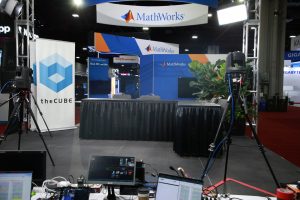The boundaries of high-performance computing are being redefined by artificial intelligence, driving innovations that prioritize scalable AI infrastructure to meet growing demands for efficiency and power.
As enterprises adopt advanced AI-ready systems, the tech industry is moving beyond theoretical applications to deliver tangible solutions. This transformation is reshaping data center capabilities, promoting sustainability and fostering collaboration across academia, government and private sectors to address global challenges, according to John Furrier (pictured, left), executive analyst at theCUBE Research.

On set with theCUBE at SC24
“I think this year you’re starting to see real build-out around the infrastructure hardware and where hardware is turning into systems,” he said. “You’re going to start to see the game change and then the era’s here, the chapter’s closed, the old IT is over, and the new systems are coming in.”
Furrier spoke with fellow theCUBE Research analysts Savannah Peterson (center) and Dave Vellante (right) at SC24, during an exclusive broadcast on theCUBE, SiliconANGLE Media’s livestreaming studio. They discussed how AI and scalable AI infrastructure are transforming high-performance computing, sustainability and enterprise solutions. (* Disclosure below.)
AI infrastructure driving innovation through democratization and scalability
At this week’s Supercomputing 2024 in Atlanta, Georgia, theCUBE’s industry analysts discussed the shift from traditional HPC to systems tailored for AI-driven workloads. Once confined to niche applications, HPC is becoming accessible to enterprises of all sizes, thanks to innovations from companies such as Nvidia Corp. and collaborations across sectors, according to Furrier.
“This year the conversation is supercomputing is democratized thanks to Nvidia’s messaging and all their work,” he said. “But now the computers on premise, the data center technologies have to be rebuilt and then connected to the cloud for customization. I think this year will be the year, the era of clustered systems, on-premise edge where it’s just the system that’s going to matter.”
The industry has seen a surge in interest from builders who are tasked with creating cutting-edge systems. These builders bridge the gap between hyperscalers, such as Amazon Web Services Inc., and traditional hardware giants, such as Dell Technologies Inc. and Hewlett Packard Enterprise Co., Furrier explained.
“There’s a new level of builder emerging. It’s the classic hyperscalers on the high end,” he said. “Then you’ve got the enterprise, like the Dells, the HPEs. They’re going to embed their devices and systems, obviously servers. They control the IT. The Broadcoms and the chip guys are targeting these new builders, because they’re going to come into the enterprise and build it.”
Central to this evolution is Nvidia’s continued leadership in AI infrastructure hardware. The company’s H100 GPUs and the introduction of Blackwell chips have set new benchmarks in performance, though not without challenges. Reports of “melting racks” have reignited discussions on sustainable cooling technologies, according to Peterson.
“We’re at that inflection … when are we going to make AI real, when are we going to start realizing some of this high-performance computing gains in terms of the world, not just in terms of prototypes?” she asked. “We’ve got this this type of a conversation going on that means innovation is moving at light speed or a super-hot speed. As someone who’s been a hardware nerd their whole life, I feel like hardware is having its moment.”
Sustainability and quantum computing: Key trends shaping HPC
Sustainability is emerging as a pivotal concern in HPC. The intersection of energy efficiency, cooling advancements and dense chip design underscores the need for long-term solutions. From direct liquid cooling to on-chip innovations, these developments are enabling more efficient systems while addressing environmental concerns.
“There’s a whole challenge of how do you cool these things, liquid cooling is now back in a big way,” Vellante said. “We’ve got a panel this afternoon on direct liquid cooling, and we have one of the foremost experts in the field coming on to talk about phase change, and there’s a big debate about whether or not that can scale.”
Quantum computing also garnered attention, with experts suggesting its hybrid integration with classical computing architectures as the next major leap. While widespread adoption may still be 24-36 months away, its potential to revolutionize encryption and scientific modeling cannot be overlooked, Furrier explained.
“Quantum’s definitely going to happen, that’s not going to dominate this year because it’s still out there,” he said. “IBM and others see it coming fast because the first order of businesses [is] get the clustered systems up and running because you got to power the software … I think the innovations in the data center is going to be this year’s theme, quantum’s right around the corner, the app frameworks is going to be key.”
Here’s the complete video interview, part of SiliconANGLE’s and theCUBE Research’s coverage of SC24:
(* Disclosure: TheCUBE is a paid media partner for SC24. Neither Dell Technologies nor WekaIO Inc., the premier sponsors of theCUBE’s event coverage, nor other sponsors have editorial control over content on theCUBE or SiliconANGLE.)
Photo: SiliconANGLE
Your vote of support is important to us and it helps us keep the content FREE.
One click below supports our mission to provide free, deep, and relevant content.
Join our community on YouTube
Join the community that includes more than 15,000 #CubeAlumni experts, including Amazon.com CEO Andy Jassy, Dell Technologies founder and CEO Michael Dell, Intel CEO Pat Gelsinger, and many more luminaries and experts.
THANK YOU
This articles is written by : Nermeen Nabil Khear Abdelmalak
All rights reserved to : USAGOLDMIES . www.usagoldmines.com
You can Enjoy surfing our website categories and read more content in many fields you may like .
Why USAGoldMines ?
USAGoldMines is a comprehensive website offering the latest in financial, crypto, and technical news. With specialized sections for each category, it provides readers with up-to-date market insights, investment trends, and technological advancements, making it a valuable resource for investors and enthusiasts in the fast-paced financial world.
